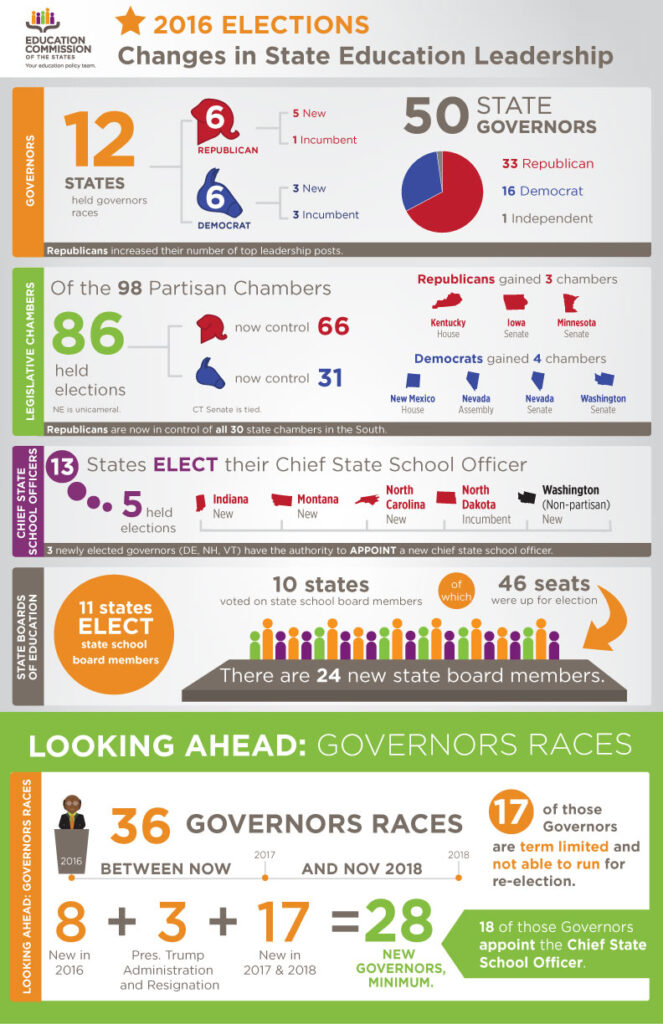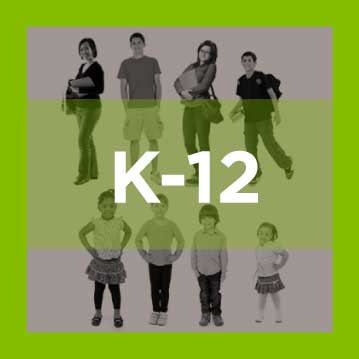Note: this blog post was updated on Dec. 15, 2016, with final election results.
The enactment of the Every Student Succeeds Act (ESSA) changed the course of education policy in the country giving states more flexibility to design and implement policy plans that best meet the needs of their students and communities. As ESSA eases federal control over education policy in individual states, education leaders and policymakers will lead the development and implementation of state-specific plans.
Outcomes from the 2016 elections impact the education landscape in several states across the country, from the governor’s office to state board of education members. Here is a quick snapshot of election results that will influence policymaking at the state level.

(for a downloadable version of this infographic, click here)
Governors – Republicans continue to dominate the states’ top leadership post with Republican governors in 33 states, Democratic governors in 16 states and an Independent governor in Alaska. Of the 12 gubernatorial races, Republicans won six and Democrats won six. Eight governors will be new to their post in January. Republicans picked up three additional gubernatorial seats in Missouri, New Hampshire and Vermont. Republicans also retained control in Indiana and North Dakota by electing new governors and kept control in Utah by re-electing the Republican incumbent. Incumbent Democratic governors in Montana, Oregon and Washington retained their seats. Democratic control was also retained in Delaware and West Virginia with new Democratic governors elected. After a close race, Democrats picked up the state’s top leadership post in North Carolina.
Gubernatorial Results:
- Delaware – John Carney (D)
- Indiana – Erick Holcomb (R)
- Missouri – Eric Greitens (R).
- Montana – Incumbent Steve Bullock (D)
- New Hampshire – Chris Sununu (R)
- North Carolina – Roy Cooper (D)
- North Dakota – Doug Burgum (R)
- Oregon – Incumbent Kate Brown (D)
- Utah – Incumbent Gary Herbert (R)
- Vermont – Phil Scott (R)
- Washington – Incumbent Jay Inslee (D)
- West Virginia – Jim Justice (D)
State Legislatures – Republicans continue to control seats in the majority of state legislatures across the country. According to the National Conference of State Legislatures, come January the Republicans will control 66 of the 98 partisan chambers. Democrats will control 31 chambers. This means that Republicans will control both chambers of the legislature in 32 states and Democrats will control both chambers of the legislature in 14 states. Three states – Colorado, Connecticut and Maine – will have split or tied legislative chambers. Nebraska is a unicameral, nonpartisan legislature.
Republicans pick up three legislative chambers. The Kentucky House, Iowa Senate and Minnesota Senate switched from Democratic to Republican control. Republicans made history in Kentucky when they took 17 seats from the Democrats to gain control of the chamber for the first time since 1922, and only the third time in state history. Republicans now control all 30 legislative chambers in southern states..
Democrats pick up four legislative chambers. The New Mexico House, both Nevada Assembly and Senate and Washington Senate switched from Republican to Democratic control.
Tied chamber. Republicans also made gains in Connecticut, a reliably blue state, where the Senate is tied 18R-18D.
Three states with split/tied chambers. Colorado and Maine continue to have spit legislative chamber party control. This down from seven states pre-election (Colorado, Iowa, Kentucky, Maine, Minnesota, New Mexico and Washington). The Connecticut Senate is tied with 18 Republicans and 18 Democrats.
For full state legislative election coverage, visit the National Conference of State Legislatures State Vote 2016.
Elected Chiefs – Of the 13 states that elect their Chief State School Officer, only five states held elections for chiefs this year – Indiana, Montana, North Carolina, North Dakota and Washington. Of the three incumbents (Glenda Ritz (D) – Indiana; June Atkinson (D) – North Carolina; and Kristen Baesler (R) – North Dakota;), only Kristen Baesler was re-elected. Republicans Jennifer McCormick in Indiana and Mark Johnson in North Carolina defeated incumbent Democrats. Sen. Elsie Arntzen (R) won in Montana. Rep. Chris Reykdal (D) won the non-partisan post in Washington.
Appointed Chiefs – Of the 12 states that had gubernatorial races, three states give governors the authority to appoint the chief. Of those three, Republicans now control gubernatorial seats in New Hampshire and Vermont, and Democrats continue to occupy gubernatorial seats in Delaware. In Oregon, the governor is the superintendent of schools and has the authority to appoint a deputy to run the department.
State Board of Education members – According to the National Association of State Boards of Education, of the 11 states that elect some or all of their state board of education members, 10 states – Alabama, Colorado, Kansas, Michigan, Nebraska, Nevada, Ohio, Texas, Utah and Washington – held elections. There were 46 state board seats up for election and at least 24 of the elected state board members are new to their position. In Utah, all eight seats up for election were filled by new members. Michigan elected two new Republicans board members which now gives them a split board with four Republicans and four Democrats. In a very close race in Colorado, the Democrats unseated an incumbent Republican to take control over the board for the first time in nearly 50 years.
Thanks to the state relations team and many Education Commission of the States staff who contributed to this blog post.














